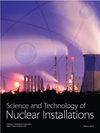A Reduced Order Model Based on ANN-POD Algorithm for Steady-State Neutronics and Thermal-Hydraulics Coupling Problem
IF 0.9
4区 工程技术
Q3 NUCLEAR SCIENCE & TECHNOLOGY
引用次数: 0
Abstract
The neutronics and thermal-hydraulics (N/TH) coupling behavior analysis is a key issue for nuclear power plant design and safety analysis. Due to the high-dimensional partial differential equations (PDEs) derived from the N/TH system, it is usually time consuming to solve such a large-scale nonlinear equation by the traditional numerical solution method of PDEs. To solve this problem, this work develops a reduced order model based on the proper orthogonal decomposition (POD) and artificial neural networks (ANNs) to simulate the N/TH coupling system. In detail, the POD method is used to extract the POD modes and corresponding coefficients from a set of full-order model results under different boundary conditions. Then, the backpropagation neural network (BPNN) is utilized to map the relationship between the boundary conditions and POD coefficients. Therefore, the physical fields under the new boundary conditions could be calculated by the predicated POD coefficients from ANN and POD modes from snapshot. In order to assess the performance of an ANN-POD-based reduced order method, a simplified pressurized water reactor model under different inlet coolant temperatures and inlet coolant velocities is utilized. The results show that the new reduced order model can accurately predict the distribution of the physical fields, as well as the effective multiplication factor in the N/TH coupling nuclear system, whose relative errors are within 1%.基于ANN-POD算法的降阶模型求解稳态中子与热液压耦合问题
中子与热工水力学(N/TH)耦合行为分析是核电站设计和安全分析的关键问题。由于N/TH系统具有高维偏微分方程,传统的偏微分方程数值求解方法通常很耗时。为了解决这个问题,本文开发了一个基于适当正交分解(POD)和人工神经网络(ANNs)的降阶模型来模拟N/TH耦合系统。详细地,POD方法用于从不同边界条件下的一组全阶模型结果中提取POD模式和相应的系数。然后,利用反向传播神经网络(BPNN)来映射边界条件与POD系数之间的关系。因此,新边界条件下的物理场可以通过ANN预测的POD系数和快照的POD模式来计算。为了评估基于ANN-POD的降阶方法的性能,使用了一个简化的压水堆模型,在不同的入口冷却剂温度和入口冷却剂速度下。结果表明,新的降阶模型可以准确地预测N/TH耦合核系统中物理场的分布以及有效倍增因子,其相对误差在1%以内。
本文章由计算机程序翻译,如有差异,请以英文原文为准。
求助全文
约1分钟内获得全文
求助全文
来源期刊

Science and Technology of Nuclear Installations
NUCLEAR SCIENCE & TECHNOLOGY-
CiteScore
2.30
自引率
9.10%
发文量
51
审稿时长
4-8 weeks
期刊介绍:
Science and Technology of Nuclear Installations is an international scientific journal that aims to make available knowledge on issues related to the nuclear industry and to promote development in the area of nuclear sciences and technologies. The endeavor associated with the establishment and the growth of the journal is expected to lend support to the renaissance of nuclear technology in the world and especially in those countries where nuclear programs have not yet been developed.
 求助内容:
求助内容: 应助结果提醒方式:
应助结果提醒方式:


